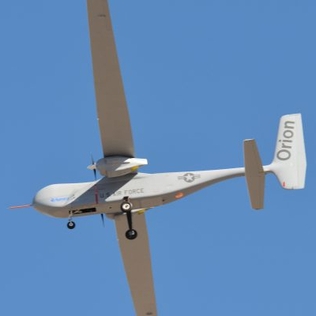
The Dassault nEUROn is an experimental unmanned combat aerial vehicle (UCAV) being developed with international cooperation, led by the French company Dassault Aviation. Countries involved in this project include France, Greece, Italy, Spain, Sweden and Switzerland. The design goal is to create a stealthy, autonomous UAV that can function in medium-to-high threat combat zones.

Unmanned Aerial Vehicles (UAVs) include both autonomous drones and remotely piloted vehicles (RPVs). A UAV is capable of controlled, sustained level flight and is powered by a jet, reciprocating, or electric engine. In the twenty-first century, technology reached a point of sophistication that the UAV is now being given a greatly expanded role in many areas of aviation.

The Northrop Grumman Bat is a medium-altitude unmanned air vehicle originally developed for use by the United States Armed Forces. Designed primarily as an intelligence "ISR" gathering tool, the Bat features 30 lb (14 kg) payload capacity that is unmatched in a 10 ft (3.0 m) wing span.

A high-altitude platform station also known as atmospheric satellite is a long endurance, high altitude aircraft able to offer observation or communication services similarly to artificial satellites. Mostly unmanned aerial vehicles (UAVs), they remain aloft through atmospheric lift, either aerodynamic like airplanes, or aerostatic like airships or balloons. High-altitude long endurance (HALE) military drones can fly above 60,000 ft over 32 hours, while civil HAPS are radio stations at an altitude of 20 to 50 km above waypoints, for weeks.

Ghatak is an autonomous jet powered stealthy unmanned combat air vehicle (UCAV), being developed by Aeronautical Development Establishment (ADE) of the Defence Research and Development Organisation (DRDO) for the Indian Air Force. The design work on the UCAV is to be carried out by Aeronautical Development Agency (ADA). Autonomous Unmanned Research Aircraft (AURA) was a tentative name for the UCAV. Details of the project are classified.

The Patroller is a French medium-altitude long-endurance unmanned aerial vehicle developed and manufactured by Safran Electronics & Defense. The airframe is based on the Stemme ASP S15 motor glider.

The Guizhou WZ-7 Soaring Dragon is a high-altitude long endurance unmanned aerial vehicle (UAV) from the People's Republic of China. The aircraft features a unique joined-wing design.

The HESA Hamaseh is an Iranian tactical and reconnaissance unmanned aerial vehicle (UAV) with high flight endurance built by Iran Aircraft Manufacturing Industrial Company (HESA). The Hamaseh was unveiled in 2013 and entered service in 2016.

CASC Rainbow is a series of unmanned aerial vehicles (UAVs) developed by the China Academy of Aerospace Aerodynamics, an entity under the China Aerospace Science and Technology Corporation (CASC). The China Academy of Aerospace Aerodynamics is also known as the 11th Academy of CASC or 701st Research Institute.
The Northrop Grumman RQ-180 is an American stealth unmanned aerial vehicle (UAV) surveillance aircraft intended for contested airspace. As of 2019, there had been no images or statements released, but growing evidence points to the existence of the RQ-180 and its use in regular front-line service. The use of the nickname "White Bat" in a 2021 video released by the US Air Force Profession of Arms Center of Excellence (PACE) suggests that the military may be preparing to release information on the RQ-180.
ASN-205 UAV and its follow-ons are Chinese UAVs developed by Xi'an Aisheng Technology Group Co., Ltd (西安爱生技术集团公司)ASN Technology Group Co., Ltd (西安爱生技术集团公司), also known as Northwestern Polytechnical University UAV Research Institute or 365th Institute, established in 1984.
The Hellenic Civil Unmanned Aerial Vehicle (HCUAV) RX-1 is a Greek research project, which has currently produced a prototype of a Medium Altitude - Long Endurance (MALE) Unmanned Aerial Vehicle (UAV), with aim for the aircraft to enter production in the future and be utilised in civil and potentially, military operations.
CASIC WJ is a series of unmanned aerial vehicles (UAVs) developed by the 3rd Academy Hiwing of the China Aerospace Science and Industry Corporation (CASIC), and the academy is also more commonly known as HiWING Mechanical and Electrical Technology Corp., or HiWING for short.
CASIC HW-600 series unmanned aerial vehicles are Chinese UAVs developed by 3rd Academy Hiwing of China Aerospace Science and Industry Corporation (CASIC), and this academy is also more commonly known as HiWING Mechanical and Electrical Technology Corp, or HiWING for short.

The Orion is a Medium-altitude long-endurance unmanned aerial vehicle (UAV) developed by Aurora Flight Sciences.

The Wing Loong-10 is a series of unmanned aerial vehicles of the High-Altitude Long Endurance (HALE) type, featuring some stealth characteristics. As of 2017, it is being developed by the Chengdu Aircraft Industry Group for reconnaissance and precision strike missions.

The Tengden TB-001 is a medium-altitude long-endurance (MALE) unmanned combat aerial vehicle (UCAV) designed by Sichuan Tengden. It is used by the People's Liberation Army.

The Chengdu Wing Loong-3 is a Medium-Altitude Long-Endurance (MALE) unmanned aerial combat vehicle (UCAV), developed by the Chengdu Aircraft Industry Group in the People's Republic of China. Intended for use as a multi-purpose platform, including anti-air, anti-submarine warfare (ASW), ground strike, maritime strike, search and rescue, and surveillance and aerial reconnaissance capabilities which can fly a maximum range of 10,000 km at medium altitude with a maximum take-off weight of 6,200 kg. Wing Loong-3 is by far the largest and first air-to-air capable model of the Wing Loong family












